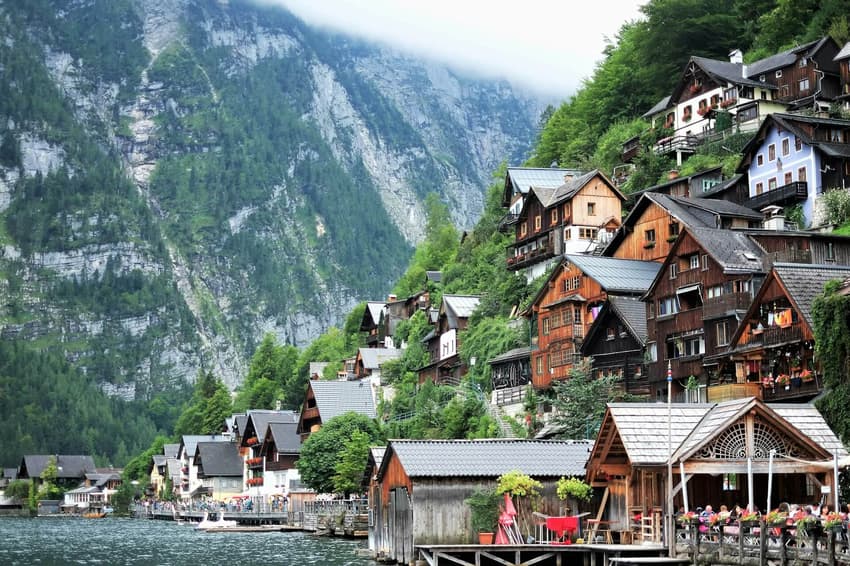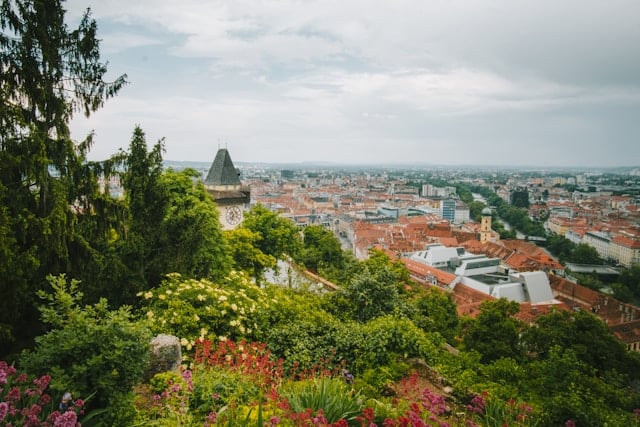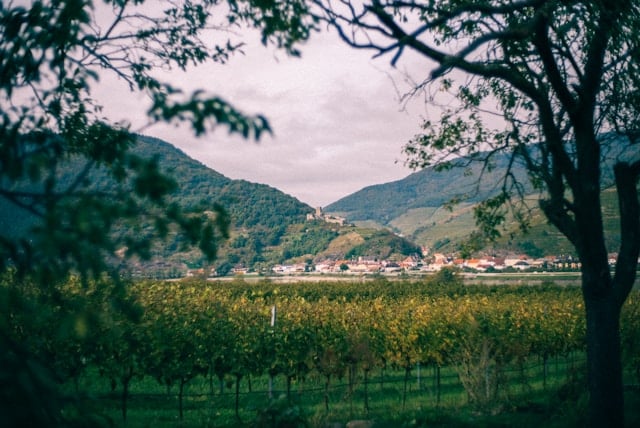MAP: Austria's 12 World Heritage sites you have to visit at least once

Austria is home to beautiful nature, historical cities, and interesting history, and some of these places are official UNESCO World Heritage sites and definitely worth a visit.
Visiting one of the 12 UNESCO World Heritage sites in Austria is a great way to spend your time.
By doing so, you can learn more about the country and at the same time, enjoy beautiful nature, explore interesting towns, and experience cultural heritage.
Here's a brief introduction to them so you can get planning.
If you want to see them all on a map CLICK HERE.

City of Graz – Historic Centre and Schloss Eggenberg
The City of Graz in Styria, together with its Historic Centre and Schloss Eggenberg, is recognised as a UNESCO World Heritage Site. It is a great example of powerful history and culture of a central European city.
The area was influenced by the powerful royal family, the Habsburgs, along with various aristocratic families. The buildings and art in Graz reflect a mix of different architectural styles and artistic movements from the Middle Ages up to the 18th century, coming from nearby regions of Central and Mediterranean Europe.
When you visit the city of Graz, you can explore a diverse and rich collection of architecture, art, and surrounding landscapes that shows you how different cultures and styles have influenced each other over time.

Fertö / Neusiedlersee Cultural Landscape
The Fertö/Neusiedler Lake area in Burgenland belongs to the UNESCO World Heritage list and has been a meeting place for different cultures for thousands of years. The landscape's diversity reflects a mixture of human actions and changes of the natural surrounding, showing how people and the environment have evolved together over time.
“The remarkable rural architecture of the villages surrounding the lake and several 18th- and 19th-century palaces adds to the area’s considerable cultural interest”, UNESCO says.
Frontiers of the Roman Empire - Danube Limes
The Danube Limes is a UNESCO World Heritage Site and extends for about 600 km along the Danube River, and a part of it is located in Austria.
Danube Limes was part of the larger Roman frontier that surrounded the Mediterranean Sea and the area is marked by various historical sites including roads, fortresses and castles. These sites represent important aspects of the Roman presence in the area and how they have fitted into the local landscape.
One of the most important parts of the Danube Limes in Austria is the Roman settlement and military fortress of Carnuntum, not far away from Vienna.
Hallstatt-Dachstein / Salzkammergut Cultural Landscape
The region Salzkammergut in the east of Salzburg, is recognised as a UNESCO World Heritage site.
The region is famous for its beautiful nature with many lakes and mountains. People have been living in the area of Salzkammergut since ancient times. The area is known for its salt deposits, which people began using as early as 2000 BC. These deposits played a significant role in shaping the economy, culture, and history of the region. Today, you can witness the area's richness by the impressive buildings in the different towns, such as Hallstatt.
“The Hallstatt-Dachstein alpine landscape, part of the Salzkammergut, and thus of the Eastern Alps, is one of visual drama with huge mountains rising abruptly form narrow valleys," UNESCO says.

Lake Attersee. Photo by Uta Scholl on Unsplash
Historic centre of Salzburg
Salzburg's Old Town, or Altstadt, is a UNESCO World Heritage Site famous because of its well-preserved medieval and baroque architecture. The city's has rich history and architectural heritage, which you can enjoy by walking through narrow streets and exploring historical buildings, squares and landmarks.
“Salzburg has managed to preserve an extraordinarily rich urban fabric, developed over the period from the Middle Ages to the 19th century when it was a city-state ruled by a prince-archbishop.”, as stated by UNESCO.
Salzburg is also the birthplace of Wolfgang Mozart, one of the greatest composers in history. Mozart's legacy is very present in the city, with numerous landmarks and attractions dedicated to his life and work.

Salzburg. Photo by Sarah Mutter on Unsplash
Historic centre of Vienna
The historic city centre of Vienna also belongs to the UNESCOs heritage. The Austrian capital grew into a bigger and more important city during Medieval and Baroque times and became very important as it was chosen the capital of the Austro-Hungarian Empire.
“Vienna played an essential role as a leading European music centre, from the great age of Viennese Classicism through the early part of the 20th century”, according to UNESCO.
Vienna's city centre is definitely worth a visit, in the capital you can explore rich architectural, baroque castles and gardens, monuments and parks, as well as the late-19th-century Ringstrasse lined with impressive buildings.
Palace and Gardens of Schönbrunn
Schönnbrunn palace and its surrounding gardens in Vienna are important parts of the UNESCO heritages. The palace was built in the 17th century as a summer residence of the Habsburg monarchs, and it is famous for its Baroque architecture and detailed interior décor.
The gardens surrounding the palace are a great place for walking or relaxing on a day off. Here you can enjoy green lawns, flower beds, fountains, and sculptures, all in a Baroque style.
As stated by UNESCO: “Schönbrunn was designed by the architects Johann Bernhard Fischer von Erlach and Nicolaus Pacassi and is full of outstanding examples of decorative art”.

Schönbrunn. Photo by Haroon Ameer on Unsplash
Ancient Settlements in the Alps
Some of the 111 UNESCO-listed prehistoric pile-dwelling sites in the Alps are located in Austria. Most of these sites can be found in Hallstatt, Mondsee, Attersee, and Fuschlsee, situated in the Salzkammergut region. Additionally, one pile-dwelling site is located in Wörthersee, in the region of Carinthia.
The pile dwellings are remains of ancient settlements, which were built on the edges of lakes, rivers, or wetlands in the Alps regions in Europe. The settlements were constructed between about 5000 and 500 B.C. During diggings at some of these sites, researchers found evidence that helps us understand how people lived back in the days, especially during the Neolithic and Bronze Ages.
READ ALSO: IN NUMBERS: The essential guide to Vienna's three outskirts districts
Semmering railway
The Semmering Railway in the Eastern Alps of Austria was constructed between 1848 and 1854, and takes its passengers on a 41-kilometre ride across high mountains
It's considered a great achievement in early railway construction. The tunnels, bridges, and other structures built during this time were so well-made that the railway is still in use today.
“It runs through a spectacular mountain landscape and there are many fine buildings designed for leisure activities along the way, built when the area was opened up due to the advent of the railway," UNESCO says.
Baden bei Wien
The Great Spa Towns of Europe is a transnational list of spa towns included on the UNESCO World Heritage List, and Baden bei Wien in Lower Austria is one of them.
Baden, as it is often called, has a rich history dating back to Roman times and while strolling around the city, you can enjoy beautiful architecture and cosy squares. The town also offers many great thermal baths with water coming from the natural hot springs in the region.
In the words of UNESCO, “All of these towns bear witness to the international European spa culture that developed from the early 18th century to the 1930s, leading to the emergence of grand international resorts".

Baden bei Wien. Photo by Roman Vasilovski on Unsplash
Wachau Cultural Landscape
The Wachau region in Lower Austria stretches along the Danube River between Melk and Krems. The area is known for its beautiful nature, and historical sites with monasteries, castles, and old towns, such as Wachau.
Here, you can experience traces of the area's long history, going from ancient times to the present day, by exploring the architecture of the towns and the many different vineyards.

Wachau. Photo by Jörg Bauer on Unsplash
Comments
See Also
Visiting one of the 12 UNESCO World Heritage sites in Austria is a great way to spend your time.
By doing so, you can learn more about the country and at the same time, enjoy beautiful nature, explore interesting towns, and experience cultural heritage.
Here's a brief introduction to them so you can get planning.
If you want to see them all on a map CLICK HERE.

City of Graz – Historic Centre and Schloss Eggenberg
The City of Graz in Styria, together with its Historic Centre and Schloss Eggenberg, is recognised as a UNESCO World Heritage Site. It is a great example of powerful history and culture of a central European city.
The area was influenced by the powerful royal family, the Habsburgs, along with various aristocratic families. The buildings and art in Graz reflect a mix of different architectural styles and artistic movements from the Middle Ages up to the 18th century, coming from nearby regions of Central and Mediterranean Europe.
When you visit the city of Graz, you can explore a diverse and rich collection of architecture, art, and surrounding landscapes that shows you how different cultures and styles have influenced each other over time.

Fertö / Neusiedlersee Cultural Landscape
The Fertö/Neusiedler Lake area in Burgenland belongs to the UNESCO World Heritage list and has been a meeting place for different cultures for thousands of years. The landscape's diversity reflects a mixture of human actions and changes of the natural surrounding, showing how people and the environment have evolved together over time.
“The remarkable rural architecture of the villages surrounding the lake and several 18th- and 19th-century palaces adds to the area’s considerable cultural interest”, UNESCO says.
Frontiers of the Roman Empire - Danube Limes
The Danube Limes is a UNESCO World Heritage Site and extends for about 600 km along the Danube River, and a part of it is located in Austria.
Danube Limes was part of the larger Roman frontier that surrounded the Mediterranean Sea and the area is marked by various historical sites including roads, fortresses and castles. These sites represent important aspects of the Roman presence in the area and how they have fitted into the local landscape.
One of the most important parts of the Danube Limes in Austria is the Roman settlement and military fortress of Carnuntum, not far away from Vienna.
Hallstatt-Dachstein / Salzkammergut Cultural Landscape
The region Salzkammergut in the east of Salzburg, is recognised as a UNESCO World Heritage site.
The region is famous for its beautiful nature with many lakes and mountains. People have been living in the area of Salzkammergut since ancient times. The area is known for its salt deposits, which people began using as early as 2000 BC. These deposits played a significant role in shaping the economy, culture, and history of the region. Today, you can witness the area's richness by the impressive buildings in the different towns, such as Hallstatt.
“The Hallstatt-Dachstein alpine landscape, part of the Salzkammergut, and thus of the Eastern Alps, is one of visual drama with huge mountains rising abruptly form narrow valleys," UNESCO says.

Historic centre of Salzburg
Salzburg's Old Town, or Altstadt, is a UNESCO World Heritage Site famous because of its well-preserved medieval and baroque architecture. The city's has rich history and architectural heritage, which you can enjoy by walking through narrow streets and exploring historical buildings, squares and landmarks.
“Salzburg has managed to preserve an extraordinarily rich urban fabric, developed over the period from the Middle Ages to the 19th century when it was a city-state ruled by a prince-archbishop.”, as stated by UNESCO.
Salzburg is also the birthplace of Wolfgang Mozart, one of the greatest composers in history. Mozart's legacy is very present in the city, with numerous landmarks and attractions dedicated to his life and work.

Historic centre of Vienna
The historic city centre of Vienna also belongs to the UNESCOs heritage. The Austrian capital grew into a bigger and more important city during Medieval and Baroque times and became very important as it was chosen the capital of the Austro-Hungarian Empire.
“Vienna played an essential role as a leading European music centre, from the great age of Viennese Classicism through the early part of the 20th century”, according to UNESCO.
Vienna's city centre is definitely worth a visit, in the capital you can explore rich architectural, baroque castles and gardens, monuments and parks, as well as the late-19th-century Ringstrasse lined with impressive buildings.
Palace and Gardens of Schönbrunn
Schönnbrunn palace and its surrounding gardens in Vienna are important parts of the UNESCO heritages. The palace was built in the 17th century as a summer residence of the Habsburg monarchs, and it is famous for its Baroque architecture and detailed interior décor.
The gardens surrounding the palace are a great place for walking or relaxing on a day off. Here you can enjoy green lawns, flower beds, fountains, and sculptures, all in a Baroque style.
As stated by UNESCO: “Schönbrunn was designed by the architects Johann Bernhard Fischer von Erlach and Nicolaus Pacassi and is full of outstanding examples of decorative art”.

Ancient Settlements in the Alps
Some of the 111 UNESCO-listed prehistoric pile-dwelling sites in the Alps are located in Austria. Most of these sites can be found in Hallstatt, Mondsee, Attersee, and Fuschlsee, situated in the Salzkammergut region. Additionally, one pile-dwelling site is located in Wörthersee, in the region of Carinthia.
The pile dwellings are remains of ancient settlements, which were built on the edges of lakes, rivers, or wetlands in the Alps regions in Europe. The settlements were constructed between about 5000 and 500 B.C. During diggings at some of these sites, researchers found evidence that helps us understand how people lived back in the days, especially during the Neolithic and Bronze Ages.
READ ALSO: IN NUMBERS: The essential guide to Vienna's three outskirts districts
Semmering railway
The Semmering Railway in the Eastern Alps of Austria was constructed between 1848 and 1854, and takes its passengers on a 41-kilometre ride across high mountains
It's considered a great achievement in early railway construction. The tunnels, bridges, and other structures built during this time were so well-made that the railway is still in use today.
“It runs through a spectacular mountain landscape and there are many fine buildings designed for leisure activities along the way, built when the area was opened up due to the advent of the railway," UNESCO says.
Baden bei Wien
The Great Spa Towns of Europe is a transnational list of spa towns included on the UNESCO World Heritage List, and Baden bei Wien in Lower Austria is one of them.
Baden, as it is often called, has a rich history dating back to Roman times and while strolling around the city, you can enjoy beautiful architecture and cosy squares. The town also offers many great thermal baths with water coming from the natural hot springs in the region.
In the words of UNESCO, “All of these towns bear witness to the international European spa culture that developed from the early 18th century to the 1930s, leading to the emergence of grand international resorts".

Wachau Cultural Landscape
The Wachau region in Lower Austria stretches along the Danube River between Melk and Krems. The area is known for its beautiful nature, and historical sites with monasteries, castles, and old towns, such as Wachau.
Here, you can experience traces of the area's long history, going from ancient times to the present day, by exploring the architecture of the towns and the many different vineyards.

Join the conversation in our comments section below. Share your own views and experience and if you have a question or suggestion for our journalists then email us at [email protected].
Please keep comments civil, constructive and on topic – and make sure to read our terms of use before getting involved.
Please log in here to leave a comment.